Scientific classification
Kingdom:
Division:
Chlorophyta
Class:
Bryopsidophyceae
Order:
Bryopsidales
Family:
Caulerpaceae
Genus:
Caulerpa
Species:
C. Prolifera
Binomial name (link Wikipedia)




Green Algae
Algues Vertes
Grüne Algen
Algas Verdes
Groene Algen
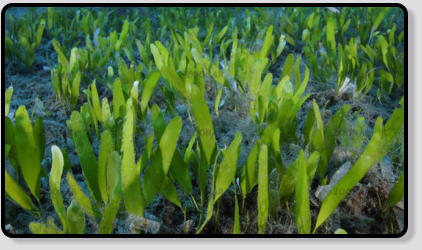
Description
Seaweed, Seetang, Aux Algues, Algas Marinas, Zeewier
Caulerpa prolifera is a species of green alga, a seaweed in the family Caulerpaceae. It is the type species of the genus Caulerpa, the type
location being Alexandria, Egypt. It grows rapidly and forms a dense mass of vegetation on shallow sandy areas of the sea.
A plant of C. prolifera consists of a number of blades or laminae linked by underground stolons which are fixed to the sandy substrate by rhizoids.
The blades contain chlorophyll for photosynthesis though the green colour is somewhat masked by other pigments. Like other members of the
order Bryopsidales, each C. prolifera plant is an individual organism consisting of a giant single cell with multiple nuclei. Chloroplasts are free to
move from one part of the organism to another as a response to the level of light at any point and there is a network of fibrous proteins that
facilitates movement of organelles. Even when derived from the same source, individual plants of C. prolifera show great variability of form and it
has been shown that this is in part related to the level of light. In bright locations, plants are compact, highly branched and dense, while in shady
locations, populations typically have blades that are longer and thinner and can more efficiently make use of the limited light available.
Two distinct forms of the alga are recognised, Caulerpa prolifera f. obovata (J.Agardh) and Caulerpa prolifera f. zosterifolia (Børgesen).
C. prolifera occurs in shallow European waters, the Mediterranean Sea and the warm eastern Atlantic Ocean and also the eastern seaboard of
the United States, Mexico and Brazil, as well as certain other scattered locations.

Plantae
Scientific classification
Kingdom:
Division:
Chlorophyta
Class:
Bryopsidophycea
e
Order:
Bryopsidales
Family:
Caulerpaceae
Genus:
Caulerpa
Species:
C. Racemosa
Binomial name (link Wikipedia)




Green Algae
Algues Vertes
Grüne Algen
Algas Verdes
Groene Algen
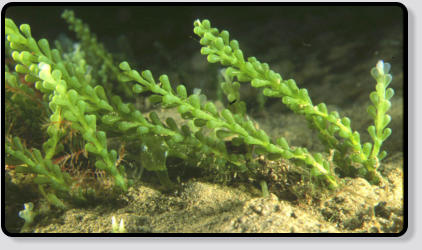
Description
Seaweed, Seetang, Aux Algues, Algas Marinas, Zeewier
Caulerpa racemosa is a species of green alga, a seaweed in the family Caulerpaceae. It is commonly known as sea grapes and is found in many
areas of shallow sea around the world. There are a number of different forms and varieties, and one that appeared in the Mediterranean Sea in
1990 is giving cause for concern as an invasive species.
A plant of C. racemosa consists of a number of branches linked to stolons which are anchored to the sandy substrate by rhizoids. The branches
are a few centimetres apart and can grow to a height of 30 centimetres (12 in). Many spherical or ovate side-shoots branch off these and give the
seaweed its name of sea grapes. Like other members of the order Bryopsidales, each C. racemosa plant consists of a single enormous cell with
a large number of nuclei. The chloroplasts containing chlorophyll are free to migrate from any part of the organism to another and there is a
network of fibrous proteins that helps movement of organelles
C. racemosa is widely distributed in shallow temperate and tropical seas. In 1926 a new form of the alga was reported off Tunisia, possibly an
immigrant from the Red Sea, and this later spread to much of the eastern Mediterranean Sea. In 1990, a new, larger form with two vertical rows
of branches on opposite sides of the stem was found off Libya. It spread widely, invading much of the Mediterranean Sea and becoming more
widespread than the invasive species, Caulerpa taxifolia. It is known as C. racemosa var. cylindracea and may have originated from Australian
waters. In America C. racemosa is found in shallow water in the Caribbean Sea, around Bermuda and along the eastern seaboard of America
from Florida to Brazil.
Plantae
Scientific classification
Kingdom:
Division:
Chlorophyta
Class:
Ulvophyceae
Order:
Bryopsidales
Family:
Caulerpaceae
Genus:
Caulerpa
Species:
C. Webbiana
Caulerpa Webbiana
Binomial name




Green Algae
Algues Vertes
Grüne Algen
Algas Verdes
Groene Algen
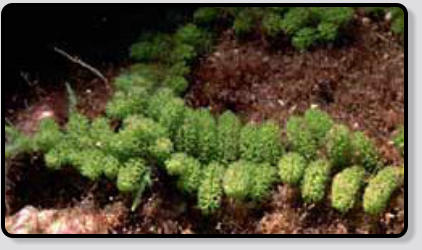
Description
Seaweed, Seetang, Aux Algues, Algas Marinas, Zeewier
No further information available on Wikipedia.
Plantae
Scientific classification
Kingdom:
Division:
Chlorophyta
Class:
Bryopsidophycea
e
Order:
Bryopsidales
Family:
Codiaceae
Genus:
Codium
Species:
C. Sp.
Codium SP.
Binomial name




Green Algae
Algues Vertes
Grüne Algen
Algas Verdes
Groene Algen
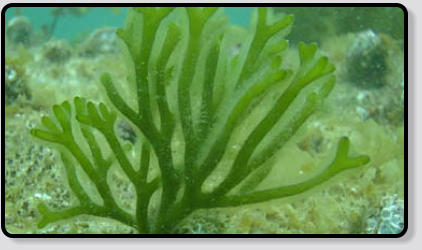
Seaweed, Seetang, Aux Algues, Algas Marinas, Zeewier
Codium is a genus of seaweed in the Chlorophyta of the Order Bryopsidales. There are about 50 species worldwide.
No further information available on Wikipedia.
Description
Plantae
Scientific classification
Kingdom:
Division:
Chlorophyta
Class:
Ulvophyceae
Order:
Cladophorales
Family:
Cladophoraceae
Genus:
Chaetomorpha
Species:
Chaetomorpha Sp
Chaetomorpha SP.
Binomial name




Green Algae
Aux Algues
Grüne Algen
Algas Verdes
Groene Algen
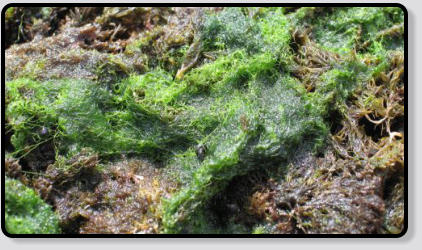
Seaweed, Seetang, Aux Algues, Algas Marinas, Zeewier
No further information available on Wikipedia.
Description
Plantae
Scientific classification
Kingdom:
Division:
Chlorophyta
Class:
Ulvophyceae
Order:
Dasycladales
Family:
Dasycladaceae
Genus:
Dasycladus
Species:
D. Vermicularis
Dasycladus Vermicularis
Binomial name




Green Algae
Algues Vertes
Grüne Algen
Algas Verdes
Groene Algen
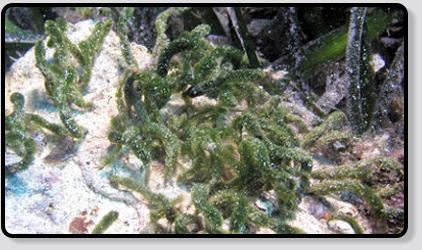
Seaweed, Seetang, Aux Algues, Algas Marinas, Zeewier
No further information available on Wikipedia.
Description
Plantae





Harry van Goor 2016
source: Wikipedia, the free encyclopedia


Categories: Green Algae






Scientific classification
Kingdom:
Division:
Chlorophyta
Class:
Ulvophyceae
Order:
Ulvales
Family:
Ulvaceae
Genus:
Ulva
Species:
U. lactuca
Binomial name (link Wikipedia)




Sea Lettuce
Laitue De Mer
Meeressalat
Lechuga De Mar
Zeesla
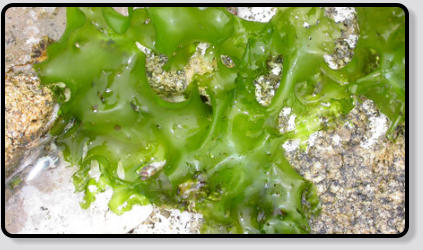
Seaweed, Seetang, Aux Algues, Algas Marinas, Zeewier
Ulva lactuca, also known by the common name sea lettuce, is an edible green alga in the division Chlorophyta. It is the type species of the genus
Ulva.
Ulva lactuca is a thin flat green alga growing from a discoid holdfast. The margin is somewhat ruffled and often torn. It may reach 18 centimetres
(7.1 in) or more in length, though generally much less, and up to 30 centimetres (12 in) across. The membrane is two cells thick, soft and
translucent, and grows attached, without a stipe, to rocks or other algae by a small disc-shaped holdfast.
Green to dark green in colour, this species in the Chlorophyta is formed of two layers of cells irregularly arranged, as seen in cross-section. The
chloroplast is cup-shaped in some references but as a parietal plate in others with one to three pyrenoids. There are other species of Ulva which
are similar and not always easy to differentiate.
The distribution is worldwide: Europe, North America (west and east coasts), Central America, Caribbean Islands, South America, Africa, Indian
Ocean Islands, South-west Asia, China, Pacific Islands, Australia and New Zealand.
Description
Plantae

